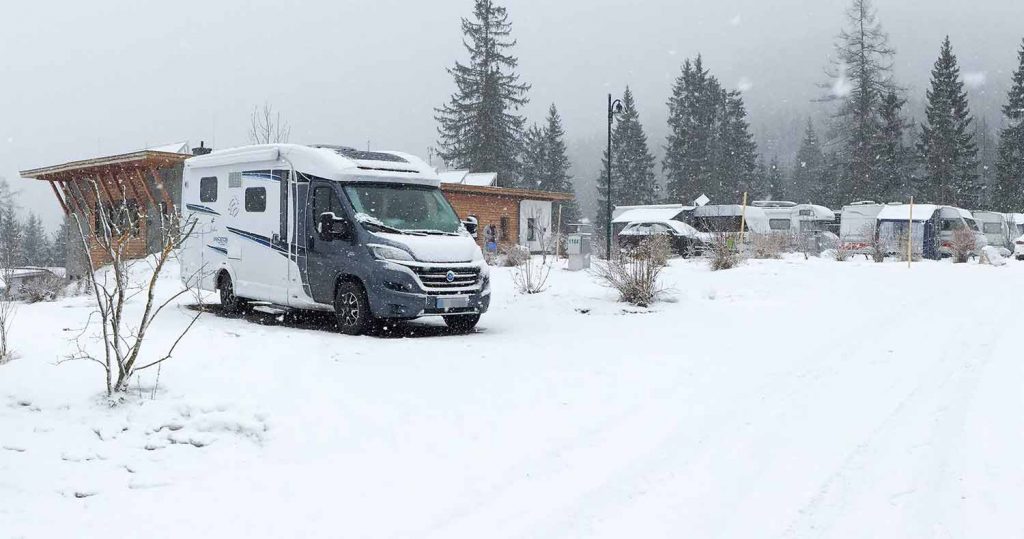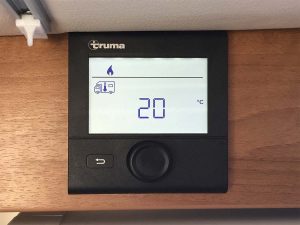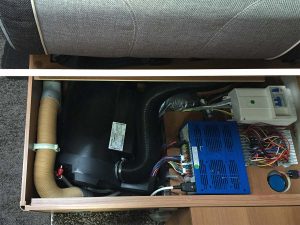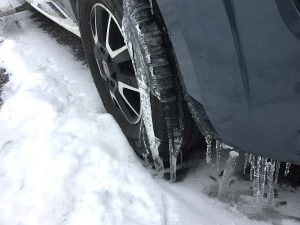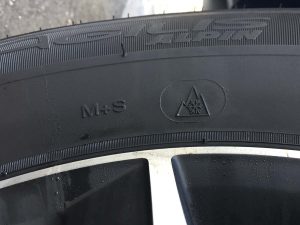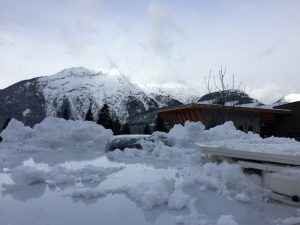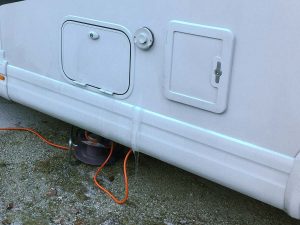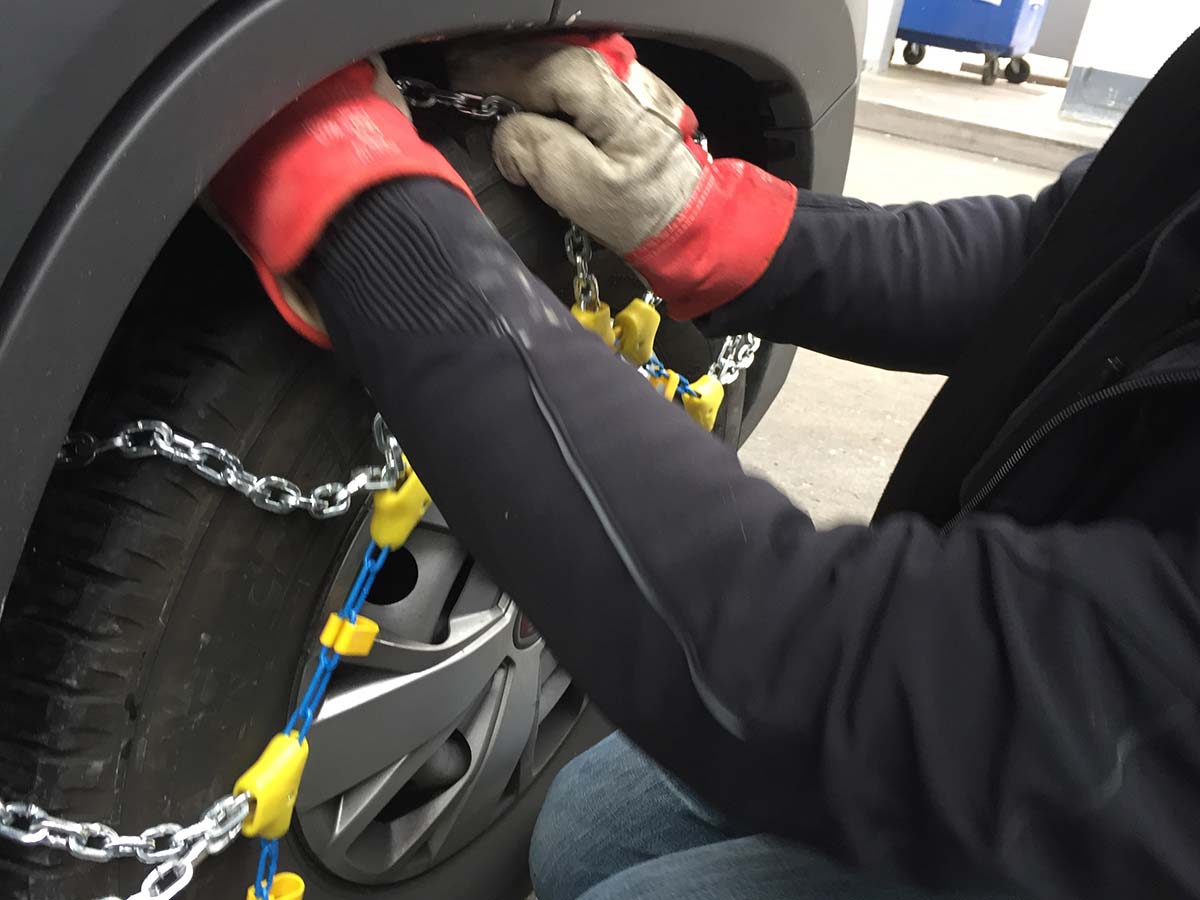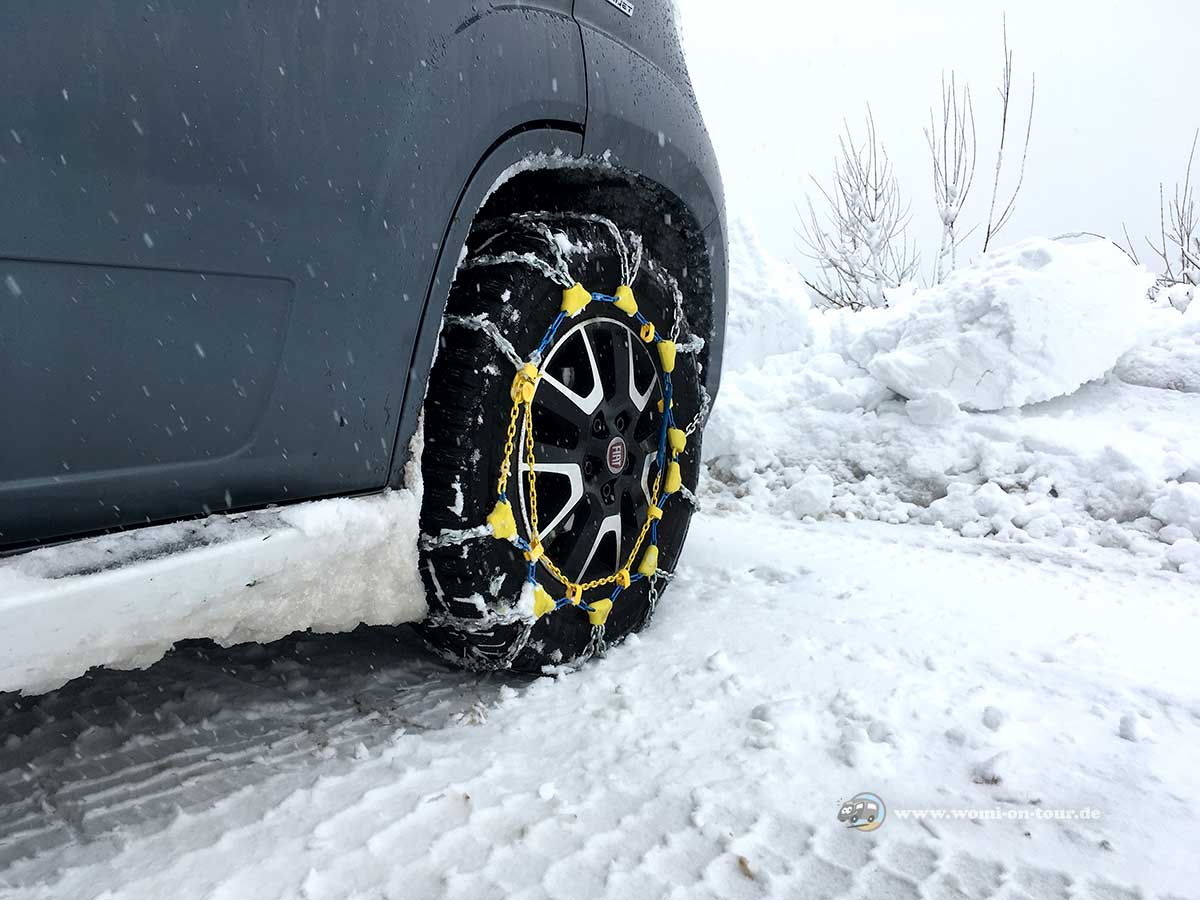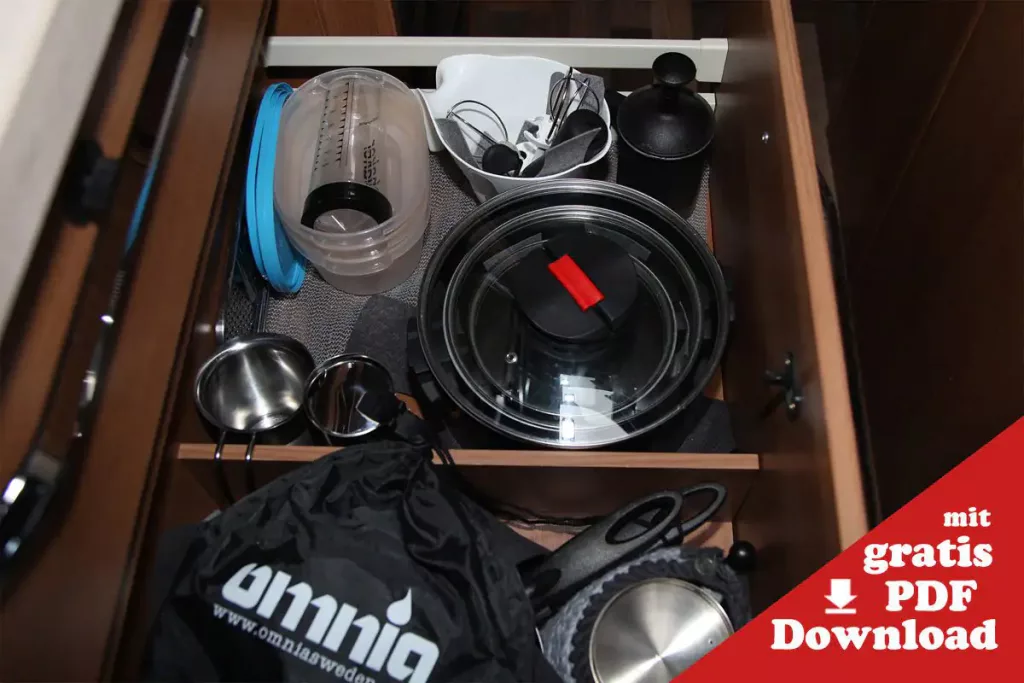Let’s talk about winter camping in this article! When winter comes and temperatures drop, we are often asked “Aren’t you cold?” or “Is your camper winterproof?” or even “Doesn’t the water freeze in the water tank?”. You probably know this too, or do you ask yourself the same questions? The answer right away: Yes, winter camping is possible with a winterproof camper or caravan and it is even fun!
A few things should be considered, because so this and that runs differently in winter than in summer. We have summarized our own experience of the last winter seasons on snowy campsites and pitches here in a guide. Have fun reading!
Please note, all tips and products are recommended from our point of view in Germany. In countries outside of Germany, other technical and legal conditions may apply.
Inhaltsverzeichnis
- What are the biggest challenges of winter camping?
- A good heater heats all critical places
- Winterproof campers heat the waste water tank
- Warm water for winter camping
- Heating distribution
- Ventilation
- Is a raised floor important?
- Poor insulation
- Covers for the refrigerator grills
- The frost guard valve
- Supply of electricity and gas
- How to check the level of gas bottles?
- Driving in cold temperatures
- Attachments, flaps and hatches
- Snow on the car
- Additional necessary equipment for winter camping
What are the biggest challenges of winter camping?
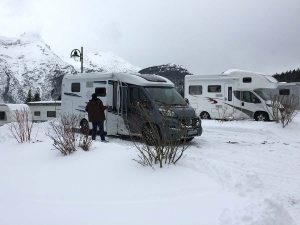
Some procedures when camping in winter are different and require a little attention. When it gets cold, not only the driving conditions of the roads change but also the environmental conditions for all the internals and fluids in the car. The following are problems that must be faced or avoided in order to be winterproof on the road:
- Freezing water in tanks and pipes in the vehicle.
- Increased need for fuel for heating (gas or diesel)
- Cold because of cooled vehicle
- Cold due to heat loss from poorly insulated areas on the car
- Snow and ice on the access roads and at the campsite
- Frozen attachments on the car, flaps and seals
- Snow on the roof of the car
Weather station with three wireless sensors *
One of our most practical pieces of equipment. With this weather station we measure the temperatures in four different places: Outdoor temperature, indoor temperature, freezer temperature and refrigerator temperature. The included three wireless sensors can be placed wherever you want to measure the temperature (and also the humidity).
(approx. 52 €)
A good heater heats all critical places
Of course, a comfortable temperature is crucial for well-being in a winter camper. This is easily achieved with a normal air heater, e.g. from Truma, which is installed in virtually all vehicles. The modern CP-Plus control panel from Truma makes it very easy to set a temperature. By means of a temperature sensor in the upper part of the car, this is controlled and regulated. However, this is not only pleasant for the people in the Womo, but also for various components in the vehicle absolutely important. Enemy number one is freezing water.
If the heating is running in the vehicle, not only the interior is heated, but also everything inside the outer walls that is halfway accessible by air and heat. By this I mean the routed water lines from the tank into the faucets, back through the sink, and into the waste tanks. And of course the tanks themselves. In our Knaus camper, the fresh water tank is located directly next to the Truma underneath the dinette seat and is heated by the waste heat from the Truma heater.
Winterproof campers heat the waste water tank
The wastewater tank is more problematic, as it tends to be located deep under the vehicle floor due to gravity and thus often outside the interior. Winterproof campers either have their own wastewater tank heater, which works electrically, or have the wastewater tank integrated into the air heater. As in our Knaus: A separate branching of the heating air – controlled by a manually operated flap valve – leads around the tank and protects it from the dangerous cooling and frost.
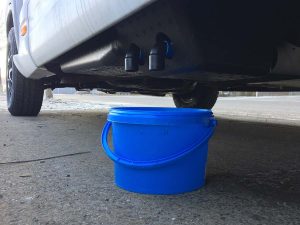
The frost monitor must also be heated. This component, which is sensitive to cold, is often located in the interior in a cabinet or, as in our case, in the service flap where the drain valves and external socket are installed. This compartment is located directly next to the Truma heater and is also heated with its waste heat. More on the frost monitor and how it works later in the article.
If you don’t really trust your waste water tank heater, or if you don’t have one at all, there is still the possibility of leaving the drain cock of the waste water (grey water) open after emptying it in an official place and placing a flat plastic bucket underneath it at the pitch. The wastewater will then gradually collect there and freeze in the bucket. The ice block or the still liquid gray water must then be disposed of regularly according to the rules.
Of course, this becomes problematic while driving. Washing your hands while standing in a highway parking lot is of course not possible. Running off water could freeze on the ground and become a danger for pedestrians and cars – and simply letting gray water run off without an appropriate disposal facility is not an option.
Let’s summarize:
- From about 7 degrees and colder heat the car around the clock, even if you are only briefly not in the car.
- The heater must also heat components such as the fresh water tank, waste water tank and frost monitor.
- Switch on additional waste water tank heating, if available.
- If in doubt, leave the gray water tap open at the parking space and place a bucket under it that is emptied regularly.
Warm water for winter camping
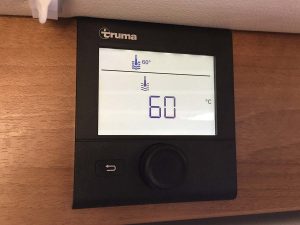
The vast majority of reasonably modern vehicles and caravans have a combi heater on board. This means a combination of air blower heating and a boiler for hot water. This boiler can be switched on independently of the heating setting and provides hot water on demand.
In winter, of course, this is particularly pleasant, because the fresh water from the tank – despite heating in the vehicle – has bitterly cold temperatures. For quick hand washing, rinsing or showering, heated water is an advantage.
Note that the boiler must be filled with water before you turn it on. This is done by running water at the sink and turning the mixer faucet to completely hot water. At first there will be hissing and whistling because of air in the system, but after a few seconds water will run quietly and without interruption into the basin. Then the boiler is filled.
Heating distribution
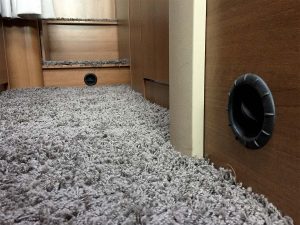
A not so pleasant point is the distribution of heat in the camper. I think that everyone who heats his motorhome in winter knows this problem. It simply gets differently warm. Regardless of whether the Truma heater is installed in the rear (often in panel vans) or further forward under the bench seat at the table (as in many semi-integrated vehicles), the heat is not distributed evenly throughout the vehicle and there are warmer and colder zones. Annoying when Mrs. Camper freezes in the back of the bed while Mr. Camper sweats at the front of the seat.
This problem can not be solved definitively, even a large number of well-distributed heating outlets does not help much. In our Knaus, for example, almost nothing warm comes out of the rear outlets, while the front is well heated. In addition, the front of the cab in a semi-integrated vehicle tends to cool down more than the more elaborately insulated rear area.
I’ve also read that it can blow in cold from the Ducato cockpit vents, especially when it’s windy outside. Switching the heating to recirculation mode probably helps here, so that the air ducts to the outside are closed.
Ventilation
What is inevitably easy in the summer is proper ventilation. When it’s warm, people like to leave the hatches open and so rarely a problem with moisture in the vehicle. In winter, it’s a different story. It is cold, the hatches and windows remain closed, moisture collects in the vehicle and leads to poor climate and in bad cases even mold. The wet shoes from the snowshoe hike do the rest.
When winter camping, it is important to keep ventilating and not to block the openings for the forced vents on hatches and doors. We are not sure if you should keep a hatch open a crack for a longer period of time. After all, that’s exactly what you’re not supposed to do in the home, because it promotes mold growth. It’s probably the same with the camper: regular shock ventilation is exceptionally important.
Is a raised floor important?
Certainly, there are motorhomes that are more suitable for winter use than others. For example, there is one feature in particular in the higher-quality class that proves its worth in winter: the double floor. A layer of air between the vehicle underbody and the floor in the car insulates and does not cool down as quickly. Compartments are often installed in the raised floor, either accessible from the outside through flaps or on the inside through removable lids in the floor. Sometimes this is also heated and is used to accommodate pipes and tanks frost-proof. Certainly an advantage in winter. But necessary for winterproof fun camping in the snow?
No. Having a raised floor is certainly nice, but in our view absolutely not necessary to have a winterproof camper. Our womi doesn’t have a raised floor either, and we travel in all seasons. However, it is crucial that important components such as the tanks and pipes are also warmed by the normal heating and can not freeze. Neither when stationary nor when driving.
To make it more comfortable for the feet, we have adapted and laid a carpet.
Poor insulation
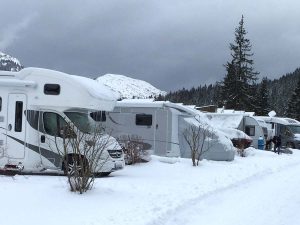
If you spend some time winter camping, you quickly notice which parts of your vehicle are better insulated and which are worse. I myself remember ice-cold doors of a van that I had borrowed for camping years ago.
In our semi-integrated, the walls of the body are better insulated compared to a panel van. Still, you notice cold spots that just aren’t sealed well enough, like the body door. In our car, there is a strong draught from below. We help ourselves with an older blanket, which we place there in the lower part of the exit. But be careful not to block the openings of the forced ventilation. In our case, these are further inside on the entrance step.
Many motorhome owners find the cab too cold and help themselves with such insulating hoods, which they wrap around the entire “face” of the Ducato from the outside. This may have an insulating effect, but we don’t like it. Who drives to a beautiful place and then blocks the view with such a monstrosity? But that is up to everyone.
I have also heard of a solution that an additional hot water parking heater is installed in the Fiat Ducato, which – like in a passenger car – then makes additional warm from the vents of the cockpit. An expensive and exclusive solution for particularly pronounced frostbite.
Covers for the refrigerator grills
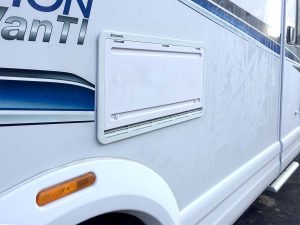
In winter, you very often see motorhome owners covering the refrigerator vents with closed plastic screens. This also makes perfect sense. If it is particularly cold outside, cold air gets into the interior through the openings and, in the worst case, causes unwanted drafts.
These panels are available in the accessories trade to fit the respective openings. For our large Dometic refrigerator, for example, there are these ventilation grille covers. You don’t have to be afraid, a slot remains open so that the refrigerator gets enough air. If it gets warmer, the covers have to go down again.
The frost guard valve
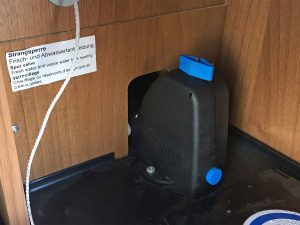
Let’s move on to a very important component when it comes to winter camping. The frost monitor safety valve, or just “frost guard” for short, protects the boiler tank of the Combi heater in the event of frost.
Normally, the valve is locked. This is also necessary to keep the water in the boiler, and indirectly in the fresh water tank. If the temperature drops below about 3 degrees, this valve opens automatically and drains the water from the boiler downwards. If the water remains in the circuit, and the temperature continues to drop, the water freezing there would destroy the boiler and other parts.
Perhaps one or the other wonders why the valve triggers already at above zero degrees. Quite simply, if frost has already frozen the drain, it is too late to drain the water. The drain would already be clogged. If the valve has triggered, it can only be closed again at a temperature of more than 7 degrees.
By the way, the frost guard is also important in summer. When you empty the tanks, be sure to open the frost monitor manually (turn the control knob 90 degrees). Otherwise water will remain in the boiler.
What does this mean for winter camping?
- Do not interrupt the heating of the vehicle when temperatures are close to freezing, even if you are absent for a short time.
- If the frost guard has nevertheless been triggered by the temperature, first heat the vehicle so that the frost monitor is at least plus 7 degrees, then close it and fill the tank with water.
- Do not switch off the air heater in favor of a fan heater. Then the interior will be warm, but the frost monitor will be cold and may drain the water.
Supply of electricity and gas
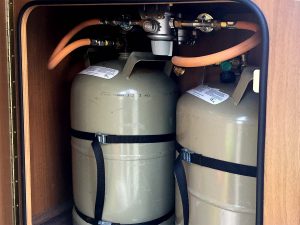
One thing is clear: in winter, you need more electricity and, above all, more gas. While in summer or the transitional seasons only little heating power is necessary, in winter it is necessary to fight against the cold temperatures. A room that is usually poorly insulated or deliberately not completely tight due to forced ventilation must be heated.
If the heating runs around the clock in frosty conditions, it is said that an 11 kg gas cylinder is sufficient for only 2 – 3 days. We can confirm this. This means the bottle exchange at the camping site or at the hardware store every few days.
Especially when traveling in cold landscapes, where a gas supply is not or only conditionally guaranteed, this means a problem. Cheers to those with a diesel heater. More fuel is also needed, but there are more reserves across the board due to the vehicle’s (filled) diesel tank. There’s no need for constant towing and changing of gas cylinders.
If the heating power is supplemented by electrically operated fan heaters or if the waste water tank heater runs on electricity, the power consumption in winter also increases significantly. On campsites with weakly fused power connections, problems can arise here. Proud owners of a photovoltaic system on the roof should also consider that in winter the solar radiation is generally not as strong as in summer. Snow lying on the PV modules can also completely paralyze power generation.
Important when winterizing the motorhome:
- Remember that gas bottles become empty relatively quickly during continuous heating.
Keep an eye on possibilities for gas supply (e.g. by bottle exchange) - Helpful for longer stays at a campsite are large gas bottles, which are connected externally (if equipment is available on the vehicle).
- When heating with fan heaters, pay attention to the product quality and safety of the fan.
How to check the level of gas bottles?
There are several ways to check the level of gray steel gas bottles. Many swear by weighing the bottles. But who wants to remove the bottle from the gas box in a complicated way? We have had very good experiences with the Truma Levelcheck. It works very simply: hold it against the bottle, press the button at the top to activate the ultrasonic measurement. In a few seconds you get an answer, whether at the tested height is still gas in the bottle or not. With several measurements, you can easily measure the level.
Truma Levelcheck *
Measuring device for determining the level of gas, e.g. in gray steel gas cylinders
Ultrasonic measurement
With integrated LED flashlight
(offers from approx. 70 €)
Driving in cold temperatures
Be careful in winter road conditions! This applies more than ever to campers and caravans. Remember, you are moving a 3.5 ton vehicle or heavier over snow and ice. Just as with a passenger car, the camper must be in winterproof condition. If you’re not sure, you should visit a garage before winter to help add antifreeze to radiator fluid and spray if necessary.
Good winter tires are an absolute must for winter campers and suitable snow chains belong in the luggage garage in winter. If the temperatures fall so slowly in the direction of frost range, it means watch out when driving. Places can quickly become slippery and bring the mobile in distress. Take your foot off the gas and keep your distance. The standard program – as in summer – is to check the lights at the front, side and rear of the vehicle. In the case of trailers, of course, don’t forget the trailer.
Attachments, flaps and hatches
When it’s freezing cold outside and you feel good inside, it’s easy to forget that the car is still stiff on the outside. Keep that in mind and think carefully about whether you need to open any hatches or windows. Roof hatches are often frozen shut by snow and ice and should not be forced open. A fresh air option must be open to operate the gas stove. Open a side window rather than a skylight.
Consider whether you actually need to extend the satellite system on the roof when there is ice and snow on the roof outside. For example, it happened to us this winter when we visited the CMT trade show that our system could not be extended and reported an error. It was so cold that probably the motor was frozen. To change this by force is detrimental to the unit.
Regular airing is mandatory in the winter. Do this regularly, briefly and forcefully, for example by opening the body door and side windows.
Snow on the car
Isn’t it wonderful when it snows outside and you sit inside nice and cozy in the warm? When it snows, a lot of snow accumulates not only next to the car but also on the roof. If it becomes too much, at the latest before the departure, the snow must be cleared from the roof. To do this, armed with a ladder and a broom, it is helpful to sweep the mountains away to the rear or to the front, depending on the condition of the roof. Be careful with the structures on the roof: take care not to damage solar panels, hatches and satellite systems.
It is also important to keep (exhaust) vents on the vehicle free of snow and ice. For example, the outlet chimney of the Truma heater must be clear. Icicles often form there, and you should remove them before you leave at the latest. You know the tip to put a clothespin there to prevent the icicle from forming on the vehicle?
Additional necessary equipment for winter camping
These are our recommendations of things you should have in your car for winter camping:
- Telescopic ladder, for example, we have the Langria 3.2 m *
- broom with long handle
- small, light snow shovel, for example, this car snow shovel *
- Winter tires mounted
- Suitable snow chains. For our tire size 225/75 R 16 on Fiat Ducato we have chosen the O-Tec rim protection chain from Ottinger *. It is supposed to be suitable for light alloy wheels. In the dry test, the application succeeded quite well and in the winter 2018/19 they have proven themselves properly for the first time.
It makes sense and is even mandatory on certain routes: suitable snow chains are part of the winter camping equipment.
*: These links are Amazon affiliate links that help fund this website. There is no downside for you.
Werbung - Letzte Aktualisierung am 2024-04-19 / Affiliate Links / Bilder von der Amazon Product Advertising API

